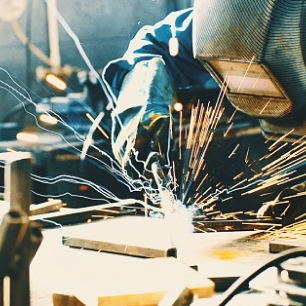Jump to:
Aim Higher!
Company owners, welding supervisors, welding teachers, and welders often tell me weld quality is important to them, but they struggle to define what it means. I’ve been told that a quality weld is one that is certified, meets a code, looks good, or doesn’t break. But to truly define a quality weld, one must be more specific.
What Is a Quality Weld?
What measurable characteristics of a weld make it look good or indicate that it won’t fail? How specifically do you measure quality? Some might say the weld has to meet the requirements of whatever code you are working under. But is a weld that meets the requirements outlined in any given code or standard a quality weld?
I invite you to remember your high school days to answer that question. What letter grade did you have to earn in high school to pass a class? In most schools, it was either a C or a D. To put it another way, a C or D was the minimum acceptable standard.
Keep that in mind as I make the following observations:
1) Any welding code or standard is, by default, a minimum standard;
2) Welding codes and standards set the baseline for what is considered acceptable practice; and
3) Producing a weld that meets the code minimum requirements can be seen as meeting the basic standards, but there is always room for further improvement in terms of craftsmanship and performance.
While passing a class with a C or a D indicates that the requirements were met, it doesn’t reflect the highest quality of work. Similarly, a weld that passes the code, while perfectly acceptable, doesn’t necessarily represent the highest quality. To return to my original question, what measurable characteristics of a weld indicate quality, and how are those characteristics defined?
The Minimum Acceptable Standard
While codes may be the minimum acceptable standard, they do give us a starting place.
To claim that a weld is high quality, it should exceed the standard outlined in the code in some measurable way.
Some measurable examples are as follows:
Many of you who are reading this list might think that it’s impossible. No one can do that consistently, or it’s too costly to enforce.
Let’s say you are right — no one can do what I have described. That still does not change the definition of a high-quality weld. If one sees the gold standard of high-quality work as the code minimum, then the code minimum is what one will produce on their best day at work. The code minimum should be the kind of work one produces on their worst day at work. To consistently achieve high-quality results, one should aim for a level that goes beyond the minimum.
Strive for Excellence
A welder’s skill should be defined by the degree of their control over any dimension or aspect of a weld. The level of quality you hold yourself to should make you uncomfortable and force you to work harder to improve yourself every time you strike an arc. Your personal standard should be higher than any external code, company, or school standard you encounter. Your standard must also be measurable, and you should possess the tools to measure it. If weld quality is important to you, pull out your V-Wac gauge or fillet weld gauges and show me how you use them.
What do I want to say when someone tells me that weld quality is essential to them? First, show me the numbers and tools you use to define and measure quality. Second, if you aim for the code minimum, you will sometimes barely hit it. Aim higher!
SETH DAVIS (seth.davis@weldingaudits.com) is an AWS CWI and owner of Welding Audits LLC, Ordway, Colo.


